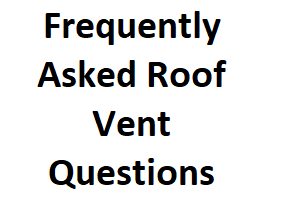Roof vents play a crucial role in maintaining a well-ventilated and energy-efficient home. They are designed to improve air circulation, reduce moisture buildup, and enhance overall indoor comfort. However, many homeowners often have questions regarding the types, installation, and benefits of roof vents. In this blog post, we’ll address some of the most frequently asked roof vent questions and provide detailed answers to those frequently asked roof vent questions to help you make informed decisions for your home.
1. What are roof vents, and why are they important?
Roof vents are specially designed openings installed on the roof of a building to allow air to pass in and out of the attic or living spaces below. They promote proper air circulation and ventilation, which helps to regulate temperature, prevent moisture buildup, and extend the life of your roofing materials. Without proper ventilation, attics can become hot and humid, leading to potential issues like mold growth, rotting wood, and high energy bills.
2. What are the different types of roof vents available?
There are several types of roof vents, each serving a unique purpose. The most common types include:
- Ridge Vents: Installed along the peak of the roof, ridge vents allow warm air to escape from the attic space while drawing in cooler air through soffit vents.
- Soffit Vents: These vents are located on the underside of the eaves or roof overhangs. They facilitate the inflow of fresh air into the attic, which replaces the warm, stale air pushed out by ridge vents.
- Static Vents: Also known as box vents or roof louvers, these non-moving vents have no mechanical components and are effective at providing continuous ventilation.
- Turbine Vents: These vents use wind power to draw out hot air from the attic. As the wind blows, the turbine spins, creating a suction effect.
- Gable Vents: Placed on the gable ends of the house, these vents enable hot air to escape from the attic space.
3. How do I know if my home needs roof vents?
Determining whether your home needs roof vents involves considering a few key factors. Signs that your home may benefit from additional or improved roof ventilation include:
- High indoor temperatures and discomfort during warm weather.
- Condensation and excess moisture in the attic, leading to mold growth.
- Noticeable roof damage, such as curling shingles or cracked wood, caused by excessive heat buildup.
- Higher than usual energy bills, especially during extreme weather conditions.
Consulting with a roofing professional can help you assess your home’s ventilation needs accurately.
4. Can I install roof vents myself, or should I hire a professional?
While some homeowners may feel confident in handling DIY projects, installing roof vents can be a complex task, and it’s crucial to get it right to avoid potential roof leaks or improper ventilation. Hiring a professional roofer with experience in roof vent installation ensures that the vents are correctly placed, properly sealed, and in compliance with building codes. Professional installation also guarantees that your roof warranty remains valid.
5. How many roof vents do I need for my home?
The number of roof vents your home requires depends on various factors, such as the size of your attic, the climate in your region, and the type of roof vents you choose. As a general rule of thumb, one square foot of roof venting is recommended for every 150 square feet of attic space. However, it’s essential to consult with a roofing expert to determine the specific ventilation needs for your home.
6. Can roof vents help reduce energy costs?
Yes, properly installed and adequately functioning roof vents can help lower energy costs. By promoting better airflow and ventilation, roof vents reduce the strain on your HVAC system. During hot weather, they prevent the attic from becoming a heat trap, leading to cooler indoor temperatures and reduced reliance on air conditioning. In winter, they help prevent ice dam formation by keeping the attic temperature consistent.
7. How often should roof vents be inspected and maintained?
Regular inspections and maintenance are essential to ensure your roof vents are functioning optimally. Ideally, you should inspect your roof vents at least once a year or after severe weather events. Look for signs of damage, debris blockage, or signs of wear. If you notice any issues, contact a roofing professional to address them promptly.
Conclusion
Roof vents are a crucial aspect of maintaining a healthy and energy-efficient home. They provide proper ventilation, prevent moisture-related issues, and contribute to the longevity of your roof. By understanding the different types of roof vents, their benefits, and the importance of professional installation and maintenance, you can make informed decisions to ensure your home remains comfortable and well-protected for years to come.
